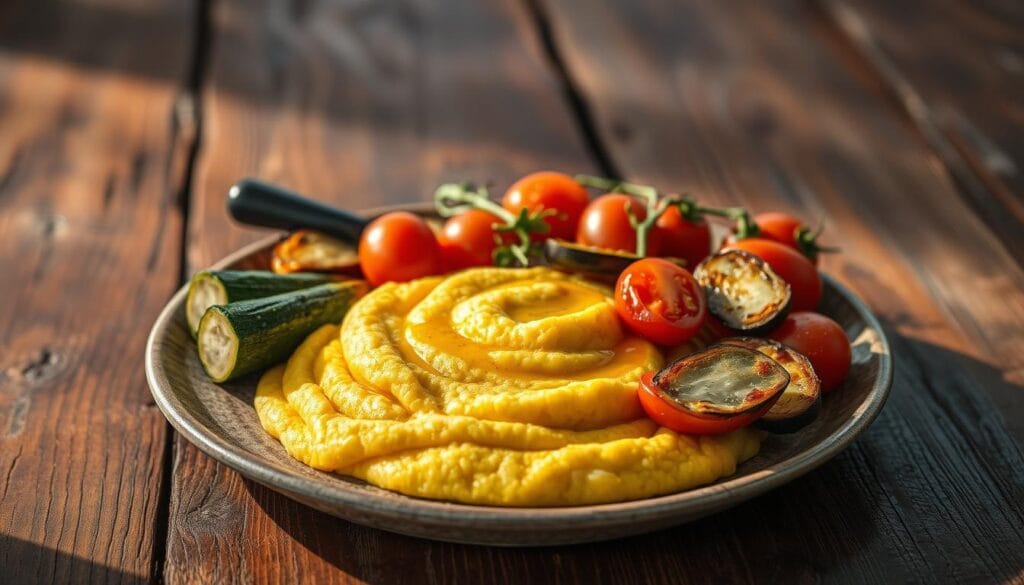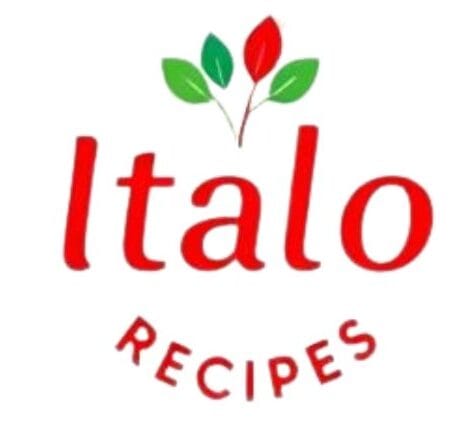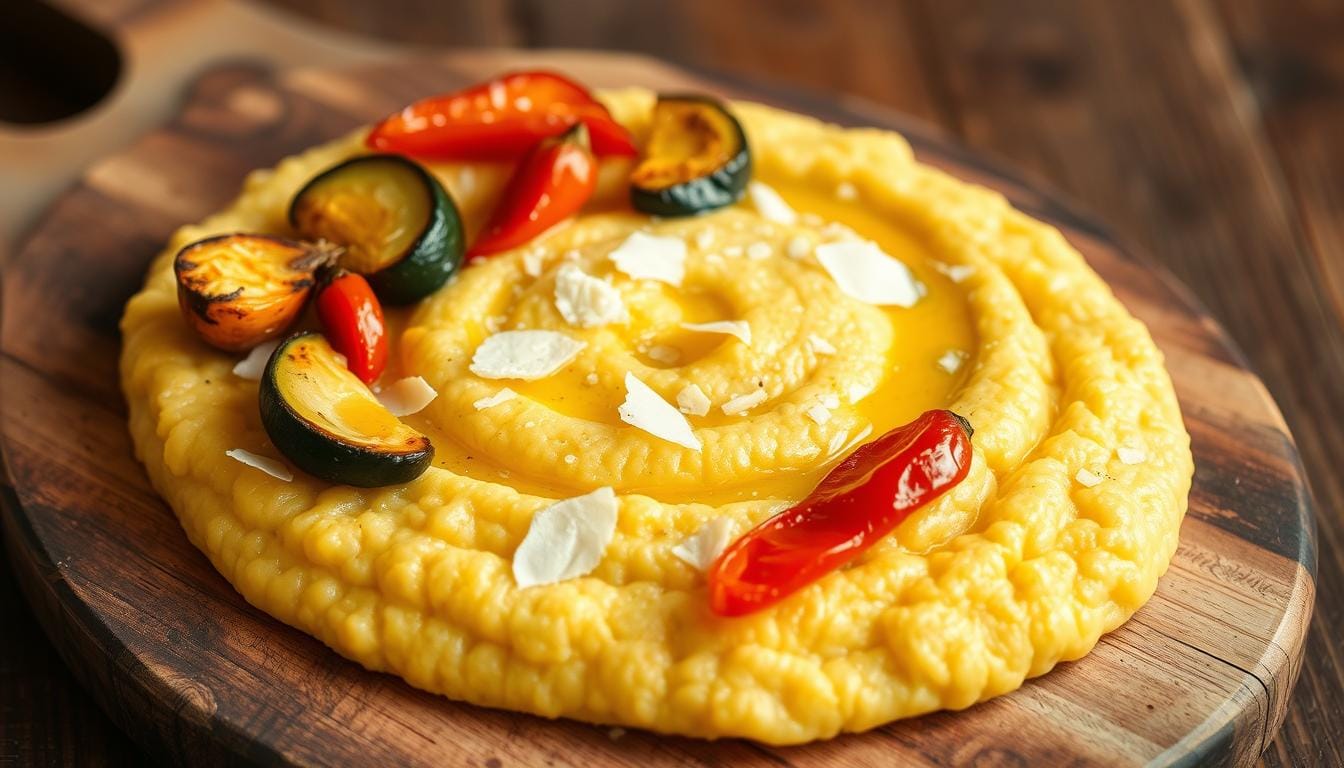Polenta with Vegetables 2025: A Comforting and Nutritious Delight in the Italian Way
There’s something special about a meal that feels like a warm hug. Polenta with vegetables—polenta aux légumes—is that dish. For centuries, Italians have made creamy polenta and paired it with roasted veggies. It’s a meal that’s both nourishing and easy to make.
Imagine a bowl of creamy polenta topped with caramelized onions, roasted tomatoes, or sautéed greens. This dish is more than just a meal. It connects us to Italy’s culinary past, made for today’s fast-paced kitchens. The key? Patience in cooking the cornmeal slowly until it’s smooth, then adding fresh, seasonal veggies.
Table of Contents
Key Takeaways
- Polenta with vegetables blends Italian tradition with modern health-focused eating.
- Coarse yellow cornmeal gives the dish its signature texture when cooked slowly.
- Vegetables add color and nutrients, making each serving both comforting and wholesome.
- Rooted in history, this dish adapts easily to dietary preferences like vegan or gluten-free.
- In 2025, it’s a timeless recipe finding new life as a versatile, nourishing comfort food.
Introduction to Polenta with Vegetables
Polenta végétarienne combines traditional Italian tastes with today’s health trends. It turns coarse cornmeal into a creamy base. This is mixed with roasted or sautéed veggies. It’s a filling dish that fits any season’s produce.
Defining the Dish
Polenta comes from Northern Italy and was once a poor man’s food. Now, polenta végétarienne updates this classic with fresh veggies. It mixes ground cornmeal into a smooth paste with veggies like roasted zucchini or sautéed mushrooms. It’s great as a main dish or a side.
Nutritional Highlights
Each serving has:
- Plant-based protein from legumes like chickpeas
- Vitamin-rich greens such as spinach or kale
- Whole grains providing fiber for digestion
Today’s recipes focus on healthy pairings. They add avocado or sweet potatoes for extra nutrients. This way, every bite is both healthy and delicious.
Deep Dive into Italian Culinary Traditions
Polenta has a long history, shaped by many generations. It started with ancient Etruscan and Roman dishes, using grains like farro before maize was known. Later, it became key in Northern Italy, where maize grew well in the Po Valley.
- Early versions used chestnut flour, evolving with New World maize in the 16th century.
- Regional twists emerged: Lombardy’s creamy polenta vs. Veneto’s firmer texture.
- Traditionally paired with game meats or wild mushrooms, it symbolized resourcefulness.
Today, recettes de polenta santé keep this tradition alive but focus on health. Chefs now mix cornmeal with quinoa or buckwheat for more protein. They also add roasted seasonal vegetables on top. These changes make the dish modern but still keep its traditional taste.
plolenta with vegetables: A Creative Twist
Making traditional dishes better doesn’t need to be hard. It’s all about being creative with ingredients and flavors. Whether you stick to recettes de polenta italienne or try new things, the secret is in using fresh ingredients. Each bite should be a tale of new ideas, yet still honor the old ways.
“The best recettes de polenta italienne balance tradition with innovation, letting fresh ingredients shine.” – Italian Culinary Institute
Choosing Fresh Ingredients
Begin with the best seasonal veggies. Use fresh zucchini, roasted bell peppers, or mushrooms for texture. Go to local markets for produce that’s ripe and smells great. This makes sure every part of your dish is strong.
- Zucchini and eggplant for crunch and creaminess
- Roasted red peppers or sun-dried tomatoes for depth
- Leafy greens like spinach or kale for earthy undertones
Balancing Flavors Perfectly
Flavors work best when they contrast. Mix earthy polenta with bright, tangy flavors like lemon or balsamic glaze. Think about these key flavors:
- Umami: Add sautéed mushrooms or Parmesan
- Sweetness: Finish with caramelized onions or a bit of honey
- Savory: Add rosemary or garlic-infused olive oil
This careful way of mixing flavors turns polenta into a blank slate for endless creativity.
Preparing Ingredients: Vegetables and More
Getting good at prepping ingredients is crucial for making plats de polenta faciles that impress. First, rinse veggies under cold water. Don’t soak them, as it can wash away vitamins. Dry them well to avoid them getting soggy later.
- Peel only when necessary. Leave skins on root vegetables like potatoes to lock in nutrients.
- Cut vegetables uniformly for even cooking. Bite-sized pieces ensure everything finishes at the same time.
- Use a sharp knife to prevent cell damage. Jagged cuts release more nutrients unnecessarily.
“The best cooking method is the one you’ll actually use,” says dietitian Carlene Thomas. “Balance nutrition and enjoyment.”
For roasted dishes, toss veggies in olive oil first. The fat boosts lycopene absorption and caramelizes edges for depth. Try slicing Brussels sprouts thin for better Maillard reaction browning, or shred them raw into salads for texture contrast. Store prepped veggies in airtight containers until ready to cook.
Tomatoes? Cut them last. Their cell walls break down quickly, releasing lycopene best when paired with healthy fats like olive oil. Carrots gain more beta-carotene accessibility when cooked, so chop them into coins for even roasting.
Pro tip: Prep garlic and onions first. Their compounds maximize nutrient retention when chopped and left to sit 5-10 minutes before cooking.
Step-by-Step Guide to Cooking Polenta with Vegetables
Learning to make polenta maison aux légumes is all about following the right steps. Here’s how to mix creamy polenta with fresh veggies easily.
Cooking the Perfect Polenta
Start by heating 4 cups of water with ½ tsp of salt in a pot. Slowly add 1 cup of polenta cornmeal while whisking. Let it simmer, uncovered, on low heat for 40–50 minutes, stirring often.
For a smooth texture, use a wooden spoon. Make sure the liquid-to-cornmeal ratio is 4:1.
- Use a heavy-bottomed pot to prevent scorching.
- Stir constantly in the first 5 minutes to prevent lumps.
Sautéing and Roasting Vegetables
To roast veggies, heat your oven to 400°F. Toss bell peppers, zucchini, and mushrooms in olive oil, garlic powder, and black pepper. Roast until they’re caramelized, about 20–25 minutes.
For sautéed veggies, heat 1 tbsp of olive oil in a skillet over medium heat. Cook for 8–10 minutes.
| Vegetable | Roast Temp (°F) | Time (minutes) |
|---|---|---|
| Zucchini | 400 | 18 |
| Cherry tomatoes | 425 | 15 |
| Butternut squash | 400 | 25 |
Combine roasted veggies with creamy polenta for a satisfying meal. Add Parmesan or herbs like rosemary for extra flavor.
Health Benefits of a Vegetable-Rich Polenta Dish
Choosing polenta et légumes rôtis is more than just tasty—it’s good for you. It mixes polenta with roasted veggies, making a meal that’s great for your health. The mix of corn-based polenta and veggies like bell peppers, zucchini, and carrots gives you fiber, vitamins, and antioxidants.
- Fiber-Rich Foundation: Polenta’s whole grain base helps with digestion and keeps you full.
- Vitamin Powerhouse: Roasted veggies add vitamin C and beta-carotene, important for your immune system and eyes.
- Heart-Smart Profile: This dish is low in cholesterol and saturated fats, good for your heart.
Polenta et légumes rôtis fits many diets. You can make it gluten-free or vegan. A 2023 study in the Journal of Nutritional Science found that such dishes lower inflammation in dieters. Using seasonal veggies makes the dish even healthier.

“The mix of polenta’s complex carbs and roasted veggies makes this dish a balanced choice for sustained energy,” says registered dietitian Maria Gonzalez of Nutrition Insight.
Using fresh ingredients makes the dish both tasty and nutritious. Whether it’s the main dish or a side, this Italian-inspired meal shows healthy eating can be fulfilling and flexible.
Tips for Customizing Your Italian Polenta Experience
Polenta crémeuse aux légumes mélangés is a canvas for your creativity. Learn to season it just right and explore Italy’s diverse traditions. This way, you can make a dish that’s uniquely yours.
Adjusting Seasoning Levels
- Try different cooking liquids: Use broth, milk, or wine to add flavor. Marsala or vermouth can bring a nice acidity to balance the earthy taste of polenta.
- Boost umami by adding savory ingredients like cooked sausage, sautéed mushrooms, or fresh herbs towards the end of cooking.
- Play with texture: For a creamier polenta, cook it for less time and stir often. For a firmer texture, cook it longer, which is great for grilling or baking.
Incorporating Regional Flavors
Italy’s regions have their own polenta traditions to draw from:
- Northern Italy: Add fontina or toma cheese for a rich taste, like in Valle d’Aosta. For Piedmont, mix in butter and shaved Alba truffle. Lombardy’s « bruscitt » pairs well with hearty yellow polenta.
- Central Italy: Try Marche’s sausage-and-rib sauce or Umbria’s spelt flour polenta with lentils.
- Southern Italy
- Molise’s « macc accunc » uses pecorino and lard.
- Puglia’s « Frascaddus » combines onion and pecorino for a smoky finish.
Mix these flavors to make a dish that’s both personal and rooted in Italy’s rich culinary history.
Serving Suggestions for a Comforting Meal
Serving your polenta with vegetables in a thoughtful way makes it even better. Comment faire de la polenta avec des légumes frais is just the start. Here are some ideas to make every bite special:
- With protein: Top warm polenta with grilled chicken, shrimp, or lentils for added protein.
- Seasonal pairings: Layer roasted squash, zucchini, or asparagus for a vibrant mix of textures.
- Light meals: Chill polenta, slice it, and serve with a peppery arugula salad.
Balance rich polenta with crisp elements. Drizzle balsamic reduction over roasted veggies for acidity. Serve alongside crusty bread to soak up sauces. For a minimalist approach, arrange polenta in a bowl, surround with sautéed greens, and sprinkle with nutritional yeast.
Seasonal herbs like thyme or rosemary add freshness. Pair with a light Pinot Noir or citrusy white wine to contrast the dish’s earthiness. Remember, comment faire de la polenta avec des légumes frais shines brightest when matched with complementary flavors.
Creative Presentation Ideas for Your Dish
Turn your polenta and vegetable dish into a masterpiece with these easy tips. Every little thing, from how you arrange it to what you add on top, makes your Italian meal pop.

Plating and Garnishing Techniques
Begin by placing roasted veggies in a spiral or circles on a warm plate. Use a spoon to drizzle olive oil in a zigzag pattern for a modern look. Add microgreens or grated Parmesan for a nice texture contrast. Here are some garnish ideas:
- Chopped fresh basil or thyme leaves
- Zested lemon rind for citrus brightness
- Smoked paprika dusted lightly around the plate
Pairing with Italian Wines
“A well-paired wine lifts the earthy notes of polenta while balancing vegetable sweetness.”
Choose medium-bodied wines that match the dish’s rustic feel. White wines like Pinot Grigio or Vermentino bring out herbaceous notes. For richer meals, go for a Chianti or Barbera. Serve in tulip glasses at cellar temperature for the best flavor.
Try different garnishes and wines with each season to make unforgettable meals. Every bite and sip should tell a story of Italian cooking art.
Adaptations for Different Dietary Needs
Polenta is great for making changes to fit your diet. It works for vegans, those who are gluten-free, or anyone watching their fat intake. Just a few tweaks can keep it tasty.
Good cooking adapts to everyone’s needs without losing its soul.
Vegan polenta: Swap butter for olive oil and dairy cheese for nutritional yeast. Use almond or soy milk to keep it creamy.
Gluten-free polenta: Use only gluten-free cornmeal. Make sure broth and seasonings are safe. Pair it with roasted veggies like zucchini or mushrooms.
Low-fat polenta: Use skim milk or broth instead of regular milk. Use less oil and add herbs like rosemary or garlic. Add spinach or carrots for extra nutrition without extra calories.
These changes let you enjoy polenta while sticking to your diet. Small adjustments make it fit any lifestyle.
Enhancing Your Cooking Skills with Easy Recipes
Make a simple polenta dish into a fun kitchen project. These tips help you change the recipe for quicker meals or family favorites. Small tweaks can turn a classic into a hit with everyone.
Quick Variations
- Stir in sun-dried tomatoes or artichoke hearts for a Mediterranean flair.
- Use an electric griddle to crisp polenta slices like pancakes in 10 minutes.
- Swap cornmeal for quinoa flour for a gluten-free option.
Family-Friendly Meals
Make dishes kids love by mixing polenta with familiar tastes. Use it as a base for baked chicken or grilled sausage. Add melted mozzarella or pesto for a fun dinner. Prep veggies like zucchini or bell peppers early to make busy nights easier.
Conclusion
Polenta with vegetables 2025 blends Italian cooking traditions with today’s health trends. Using fresh ingredients like roasted bell peppers or sautéed mushrooms honors old ways. It also makes a meal that’s both healthy and flexible.
This dish is great for a quick lunch or a cozy weekend dinner. It’s simple yet creative. Traditional methods like slow-cooking polenta and lightly seasoning veggies bring out rich flavors without too much.
Adding herbs like rosemary or Parmesan lets you adjust the taste to your liking. Pairing it with Italian wines like Chianti or using Food Network’s plating ideas adds elegance. Yet, it’s still easy to make.
With fiber from veggies and protein from polenta, this dish is good for your health. Try Bon Appétit’s recipes or make gluten-free versions to fit any diet. Polenta with vegetables 2025 is a classic dish that fits today’s tastes perfectly.

